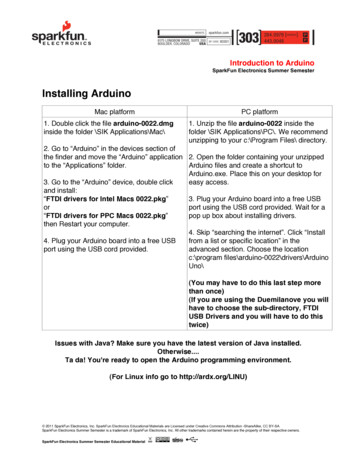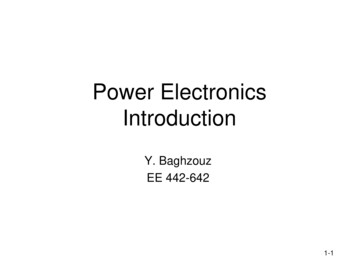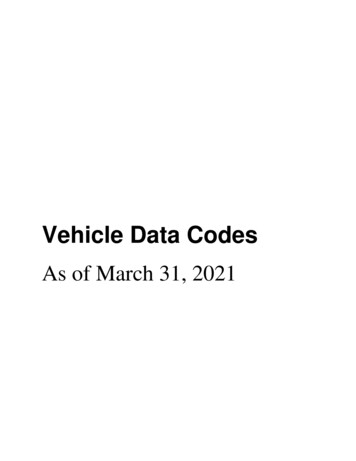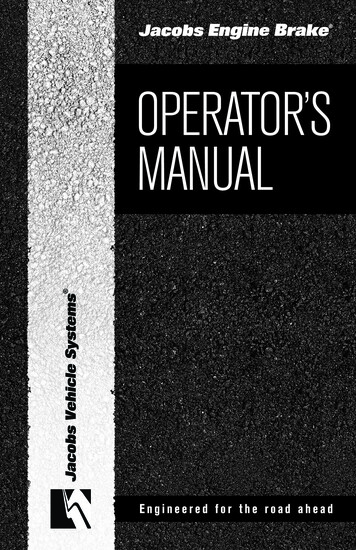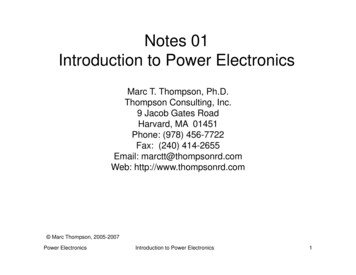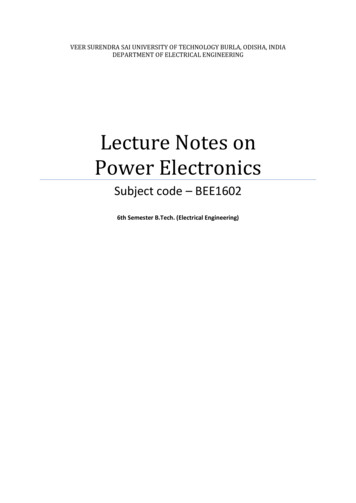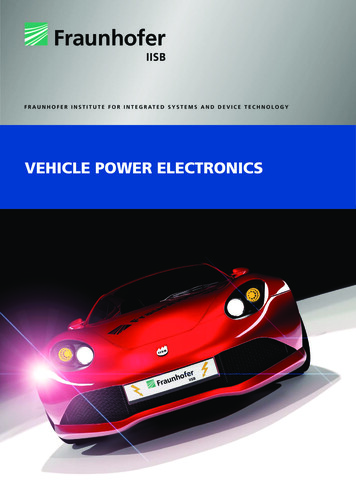
Transcription
VEHICLE POWER ELECTRONICSPower
We Develop Advanced Vehicle Power Electronicswith Innovative Solutions and Outstanding PerformanceAs an application-oriented research institute, our maininterest is to advance into new ranges of system performance and to open up new fields of applications forhigh performance and cost efficient power electronicsolutions. This is both a challenge and an incentive tous. To find creative solutions, we are ready to move offbeaten track whenever necessary.Research and development projects are carried out byhighly qualified teams of engineers and technicians. Allof these teams work in a number of well-equippedpower electronics laboratories with access to a widerange of simulation and design tools, modernmeasuring, testing, and analysis equipment, as well ascutting-edge assembly and joining technologies. Thefact that we make use of latest components, materials,and methods goes without saying.petence Center (www.ecpe.org), partner in theBavarian Cluster “Leistungselektronik” (Power Electronics), the ENERGIEregion Nuernberg e.V., and theFraunhofer Forum ElektroMobilität e.V. in Berlin, wecooperate on international and regional levels.For an overview on all activities of our powerelectronics competence center please refer also to thebrochures on energy electronics, devices, modules,and reliability (available from our homepagewww.iisb.fraunhofer.de).Our partners are from small and medium sizedenterprises, science and industry. As an ECPE Com-From semiconductor devices to high efficiency and power density systems for vehicle integrationOur Automotive Power ElectronicsExperts TeamsVehicle ElectronicDepartmentHead: Dr.-Ing. Bernd Eckardt4 Research Groups40 Engineers and TechniciansPhone: 49 9131761 139bernd.eckardt@iisb.fraunhofer.deDrives and MechatronicsAC/DC ConvertersHead: Dr.-Ing. Maximilian HofmannHead: Dr.-Ing. Stefan ZeltnerPhone: 49 9131 761 385maximilian.hofmann@iisb.fraunhofer.dePhone: 49 9131 761 140stefan.zeltner@iisb.fraunhofer.de Electric DrivetrainsInverter Development3D Integration, MechatronicsE-Vehicle Test Center Vehicle to GridInsulating ConvertersModular Power ElectronicsCircuit SimulationRF-Electronics and EMCDC/DC ConvertersHead: Dipl.-Ing. Christopher JoffeHead: Dipl.-Ing Stefan MatlokPhone: 49 9131761 296Christopher.joffe@iisb.fraunhofer.dePhone: 49 9131 761 176stefan.matlok@iisb.fraunhofer.de Inductive Power TransmissionHigh Frequency SiC/GaN ConvertersEMC Test SiteSemiconductor Characterization DC/DC Converter SystemsDigital ControlSystem SimulationSystem Integration
Power Electronics for ElectromobilityPower electronic systems are key components for anyhybrid or electric vehicle. All these vehicles – apart fromsome bikes and micro hybrids – require a high-voltagepower net with a voltage above 60 V in addition to thetraditional 14 V net. This high-voltage power net mustbe electrically isolated from the low-voltage net andvehicle chassis for safety reasons.Fraunhofer IISB takes a top position internationally inthe field of power electronics for electromobility. This isexpressed in a variety of development projects with alllarge automotive manufacturers and suppliers. Many ofthe results have gained international attention.We permanently strive to open up new applicationsand functionalities. The grid integration of electric vehicles, e.g., will gain more and more importance in thefuture. For avionic applications the new possibilities ofmodern power electronics will pave the way towardsthe “more electric aircraft”. This means powering manymore actuators electrically in order to improve the overall fuel economy, and to reduce the maintenanceefforts associated with hydraulic systems.A high-voltage vehicle power net must contain anelectrical energy storage and a traction drive inverter.Highly different vehicle concepts do exist, however,which include further high-voltage power electronicsubsystems, such as DC/DC converters for supplying alow-voltage net, inverters for, e.g., an electric air-concompressor, oil or cooling water pumps, DC/DCconverters for stabilizing the traction bus voltage, orAC/DC converters as an uni- or bidirectional vehicle-togrid interfaces.Fuel Cell VehiclesDCHigh Power LoadsDCDC x by wire active suspension air conditioning electric turbochargerxCPlug-In Hybrid and Electric VehiclesAC ACDCDCbackboneHigh voltageDCSmart LiIo-Battery SystemsElectric Traction DrivesAC ACDC14VPowernetDCDCOur R&D focus: The whole spectrum of power electronic systems necessary for future vehicles
Electric Drives and Inverter SystemsThe development of efficient, highly integrated andsafe electric drive-systems plays a key role for theelectrification of individual mobility. A few basice-motor configurations cover most of the electric driveapplications in hybrid and all-electric vehicles: one ortwo electric motors in a single housing and wheel-hubmotors. For all these configurations, innovative, costeffective, and space-saving solutions for a system integration of the power electronics into or close to theelectric drives are developed at Fraunhofer IISB.For controlling the customer-specific inverters, auniversal software platform is available with modelbased implementation and a direct link betweenMatlab/Simulink and our powerful 32-bit targetprocessor. Hardware and software development iscarried out under consideration of ASIL requirements.Integrated Drive SystemsFollowing our smart drive approach, no complex HVharness is required for the electric power train - only ashielded DC-link cable connecting to the energystorage. EMC problems are reduced significantly byavoiding any AC cabling in the vehicle. This placementof electronics close to electric machines or even close tothe internal combustion engine in hybrid cars leads to ahigher level of thermal and mechanical stress. The useof common material concepts and innovative joiningtechnologies, for example double-sided nano-silversintering of semiconductor devices, enables us toachieve the required robustness.15 cm60 kW SiC-inverter for high-speed drivesNovel Wide-Band-Gap (WBG) semiconductors, like SiCand GaN switches, offer the potential for invertersystems with highest efficiencies, power-densities andespecially switching frequencies far beyond the stateof-the-art. High-speed electric motors, like compressorsand electric turbo-chargers, require higher inverteroutput-frequencies and therefore higher switchingfrequencies to avoid additional losses and torque-ripplewithin the machine.In order to meet these demands, investigations andproduct-developments of inverters with wide-band-gapsemiconductors are carried out. An example is a 60 kWinverter system. The use of siliconcarbide 1200 VMOSFETs, ceramic-capacitors and a low inductivesystem design allow switching frequencies up to100 kHz at reasonable efficiencies. The novelsemiconductors with their reduced losses enabled apower-density of the overall power-stage of 150 kW/lwhich is far beyond state-of-the-art.The inverter is realized in B6 topology and consists ofthree half-bridge DCB-powermodules equipped with25 mOhm SiC-MOSFETs. A broad input voltage rangefrom 900 VDC to 200 VDC is covered. The whole systemis realized in a highly compact mechatronic package.To summarize, we offer the following services forelectric drive and inverter developments: Highly integrated drive solutions for hybrid orelectric vehiclesSingle-wheel axle drive with attached double inverterThe axle drive-unit in the picture above includes twomechanically independent induction motors (IM) withreduction gear (6:1). Each motor has a peak-power of20 kW and a maximum torque of 500 Nm. The 600 VIGBT double inverter with 2 x 45 kVA output power isdirectly integrated in the electric drive system sharinghousing and cooling with the e-motors.SiC and GaN Inverter for Highest Efficiencies andMotor-SpeedsWith state-of-the-art inverter systems (e.g. using SiIGBTs and Si-diodes) the switching frequency in higherpower-ranges is typically limited to values of 10 to20 kHz due to high dynamic losses. Complete in-house development and testing ofinverter power electronics (incl. 3D integration) Development of WBG-inverter systems for highestswitching frequencies and efficiencies Vehicle integration of electrical drive and powermanagement systems Motor control development for various machines(e.g. PMSM, IM, SSM, BLDC etc.) Functional safety concept (ISO 26262, up to ASIL-D)Contact:Dr. Maximilian HofmannPhone: 49 9131 761-385maximilian.hofmann@iisb.fraunhofer.de
Mechatronic System IntegrationThe trend towards miniaturization and systemintegration in power electronics is mainly driven byapplications with severe space restrictions such asautomotive, robotics or avionic. Major challenges arisefrom the fact that the installation space in theseapplications is usually predefined by mechanicalrequirements with less consideration for powerelectronics needs. This often results in complexgeometries and contamination in addition to highthermal and mechanical stress. However, the better useof space, the avoidance of expensive cables and failureprone connectors, and the reduction of EMI filterexpense make it necessary to choose this path.Experience with air, water/glycol and oil cooling is available. Vehicle-specific requirements, such as coolanttemperatures up to 115 C and high vibrational loadsare taken into consideration.A mechatronic system integration requires more thanjust increasing power density. We are working on innovative integration concepts as well as on new device,interconnection, and cooling technologies that foster a3D integration, increase ruggedness, and decreasecosts of power electronics.Our focus is on: Customized power electronic systems for vehicleapplications (automotive, railway, avionic, etc.), Vehicle integration of electrical drive and powermanagement systems, Mechatronic integration of power electronicsinto vehicle components (incl. 3D integration), Advanced thermal management, High voltage safety concepts, EMC concepts and solutions, Traction energy storage, Simulation of power electronic systems withina vehicle environment,Wheel-hub-motor integrated 1200 V SiC-inverterVarious concepts and solutions for the integration ofelectric motors and inverters into the drivetrain ofpassenger cars have been developed. Each design isadapted to the different locations of the e-drive withinthe drivetrain. Studies on hybrid and fuel cell vehicle powertraintopologies with special emphasis on topics likeoverall performance, efficiency and system costs.Contact:Hubert RauhPhone: 49 9131 g High Power DC/DC Converters for Power Train Energy ManagementOur high voltage, non-insulating, bidirectional converters are mainly used for traction energy management incase of recuperation, boost, the management ofdifferent power sources (e.g., fuel cell and battery), andfast charging. The DC/DC converters covers a powerrange up to about 600 kW with efficiencies up to 99%.Combining the DC/DC converter with a drive inverter interms of system integration is as possible as an integration into the electrical energy storage. The type ofcooling (air, water, or oil) is generally tailored to thespecific application. A fully digital control and a CANbus interface for the communication with a vehiclecontrol unit is standard.We make use of the latest Si, SiC, and GaN devices.Our multi-phase concept makes it possible to shift thefundamental frequency of the DC link ripple voltage inthe megahertz range, resulting in a considerable reduction of weight and volume of the passive components.Robust and High-Speed 300 A, 450 V buck / boost DC/DCConverter for universal drive train applications
Power density improvements by SiC and GaNWe build complete systems for our industrial partners,including high-power and bus connectors. Integrated ina sealed housing, these robust compact devices areused in R&D hybrid, electric and fuel cell cars forevaluating the electric power train. Efficiencies up to99% over a wide range of load can be realized via aload-adaptive management of the number of activephases. In our power density figures EMI filters, thecontrol electronics, and the fluid cooler are generallyincluded. The high power density and low power toweight ratio of our DC/DC converters make themespecially suitable for demanding motor sports (KERS)and aircraft applications.Key aspects: Ultra compact and efficient converter solutions User specific housing, layout, communication andelectrical power specification High Speed control loops for stability and savehandling even of load dumpsContact:Stefan MatlokTel. 49 9131 761 176stefan.matlok@iisb.fraunhofer.deInsulating DC/DC Converters for connecting board grids and supplying auxiliary devicesFraunhofer IISB develops all kinds of insulating DC/DCconverters for mobile applications. This includes e.g.insulating high voltage (up to 850 V) to low voltage(commonly 14 V, 24 V or 48 V) converters in the powerrange from 10 W up to approx. 5 kW. With efficienciesof up to 97% and power densities up to 10 kW/dm³,they can be easily integrated into a small car, directlyinside the high voltage battery system or the driveinverter. The photo to the right gives a closer look athow by using modern power devices, full digital controltechniques, and mechatronic approaches, outstandingpower densities and efficiencies are reached.As with other Fraunhofer IISB vehicle electronicsprototypes, insulating DC/DC converters can bedeveloped for plug-and-play installation, withautomotive qualified connectors. It could be usedwithin two different voltage ranges for applications inlight or heavy trucks and can be controlled via CANinterface. Due to the serial connectable phases on theprimary side, the use of automotive qualified Si powersemiconductors with 600/650 V blocking voltage ispossible to reach a DC-Link voltage up to 800 VInsight of high power density insulating DC/DC converter Galvanic isolation Supplying of high power demand auxiliary devicesin vehicles
Very high power density up to 5 kW/dm³ High efficiency up to 95 % Very high input voltages (up to 850 V) Modular Multi Level Design Automotive qualified (Si) power semiconductorsContact:Bernd SeligerTel. 49 9131 761 288bernd.seliger@iisb.fraunhofer.deDr. Stefan ZeltnerTel. 49 9131 761 140stefan.zeltner@iisb.fraunhofer.deInsulating 5 kW DC/DC converter from 750 V to 24 V for trucksBattery Chargers – Conductive & Inductive Solutions for Electric & Plug-In Hybrid VehiclesIn the field of conductive vehicle battery chargers,Fraunhofer IISB follows a modular design approachbased on 3.7 kW galvanic isolated AC/DC converterunits. With the modular circuit design approach, we areable to develop and realize a broad on-board chargerproduct line for 3.7 kW, 7.4 kW, 11 kW and 22 kWdemands.tolerance, lightweight pick-up, and a minimal packagevolume compared to underbody systems.Positioning tolerant inductive charging solutionHigh power density 3.7 kW battery chargerBesides pure battery chargers we also provide chargerswith extended functionalities, such as bidirectionalenergy flow for applications in vehicle-to-grid scenarios,or an integrated mobile power socket (e.g. 230 VAC). High power density and high efficiency User and application specific design Wide input voltage range Supporting charging mode 2 and mode 3according DIN EN 61851-1Contact:Christopher Joffe (inductive charging systems)Tel. 49 9131 761 296christopher.joffe@iisb.fraunhofer.de22 kW battery charger (developed in cooperation with AudiElectronics Venture GmbH (AEV) within the BMBF researchproject e performance)In the field of inductive charging systems we offersolutions with high transfer efficiency and small strayfields through minimal air gap, high positioningDr. Stefan ZeltnerTel. 49 9131 761 140stefan.zeltner@iisb.fraunhofer.de
Electro Magnetic Compliance – EMC Tests for Automotive and Industrial ApplicationsThe EMC lab at Fraunhofer IISB offers pre-compliancemeasurements during the development process of ourprototype systems and the components of our industrial partners. We offer a broad range of services fromconsulting in case of EMC problems via differentmeasurements according to harmonized standards tovery detailed circuit and layout optimizations.In the EMC test chamber we can perform, e.g., conduct emission measurements on electric or hybrid carswith the vehicle’s own radio antenna according toCISPR 25 as well as many standard tests on componentlevel.The immunity to electromagnetic interferences can betested in our Fully Anechoic Room (FAR) according toindustrial and automotive standards. These tests include all relevant pre-compliance measurements in thecontext of a homologation testing according to2004/104/EG directive or ECE R10 Rev. 3 of the UnitedNations.Our engineers have longtime experience in the field ofelectromagnetic compliance (EMC) and interference(EMI). They are working in several national standardization committees. We can thus guarantee competentexpert advice and up to date information on EMCtopics to our partners.Contact:Thomas SmazinkaTel. 49 9131 761 285thomas.smazinka@iisb.fraunhofer.deEMC test set up of a HV DC/DC converterAutomotive System Simulations - From Vehicle to Chip LevelThe automotive targets regarding cost, size, weight,and reliability cannot be met if either irrelevantmaximum requirements are specified or unnecessarysafety margins are designed in. A prerequisite foroptimized, tailor-made designs are simulations of theentire powertrain under different driving cycles. Ourspecial focus is on the resulting load conditions of thevarious power electronics components. In order to getrealistic data about the transient temperature behaviornecessary for lifetime and reliability analyses, thermalmodels are linked to all relevant power electronicscomponents. For simulations we use a Matlab/Simulink environment. This enables us to perform analysesregarding parameters like e.g. powertrain efficiency,vehicle operating strategy, energy storage load, orcruising range. Standard and artificial driving cycles areused, as well as real ones measured with our GPSbased vehicle data recorder.Driving CyclesMission ProfilesLifetime andReliability ModelsAmbient temperatures strongly influence the cruisingrange of electric vehicles due to the required energy forheating and cooling the passenger compartment andthe battery system. New approaches investigate the useof heat pumps and thermally insulated cabins. Inaddition, thermal preconditioning of the vehicle, usingexisting thermal masses significantly reduces the required battery energy. An overall vehicle energymanagement, comprising thermal and electrical energy,allows efficient reuse of even minor losses in theelectric drive-train for heating purposes.Contact:Dr. Bernd EckardtTel. 49 9131 761 139bernd.eckardt@iisb.fraunhofer.deVehicle andPowertrain /Simulink PSpice , MathCad Static and TransientComponent TemperaturesThermal ModelsFuel Economy, CruisingRange, AccelerationEfficiency Calc.PowerLossesAutomotive system simulation – a key competence for any application specific optimization of power electronic systems
Energy Storage Systems and Energy Management SolutionsOur focus is on fully customized cost efficient electricenergy storage and management system solutions formobile and stationary applications. Our activities rangefrom development of embedded energy managementsoftware to the design of complex, high-power energystorage systems for electrically propelled vehicles (e.g.,automobiles, bikes, motorcycles and other types ofroad vehicles, aircrafts, ships and submarine vehicles)and for smart grid applications in combination withrenewable energies (i.e., in private household andindustrial utilization).Collaborating directly with globally renowned batterycell suppliers worldwide, we provide our experience inthe fields of safety management and cell monitoring,passive and active cell balancing methods, chargingand discharging controls. Assembly and interconnect,thermal management and cooling, as well as in interfacing and communicating between components areamong our expertise, constituting a modern mobile orstationary cost-efficient electric storage system solution.Full-custom Battery SystemsAt Fraunhofer IISB, we develop highly innovative, costefficient energy storage systems, including batterymonitoring and management hardware and its embedded software, battery module and pack modeling anddesign, as well as sensors and actuators for increasedreliability and safety.Full-custom battery system design,thermal and electrical engineeringincludingmechanical,So we can offer our customers the development andrealization of state-of-the-art traction battery systems(BEV/HEV) – from the first concept to the in-housetesting of the complete system: Electric specification, e.g. voltage-level andcapacity, according to the customer requirementsSmart battery system based on lithium-ion batteries for anhigh-performance electric vehicleThroughout the engineering of traction energystorages, all necessary competences work together atFraunhofer IISB. Especially with a view on modernlithium-ion battery cells supplying the power train inelectrified vehicles, topics like internal and externalhazards are of vital importance. Use of the best fitting lithium ion cell technology(high energy-cells, high power-cells or combination) Adapted cell-monitoring and battery-managementsystems Customer specific electrical (power/signal) andmechanical interfaces If required: implementation of additional powerelectronic-components directly into the batterysystem (e.g. HV or LV-DC/DC-converters) Thermal management from system- to the cell-level(e.g. liquid- or air cooling, one-sided or doublesided cooling) 3D mechanical design development with individualvehicle integration Modular design approach for a cost-efficient laterindustrialization and a safe handlingHigh performance modular lithium-Ion battery module withContact:Dr. Bernd EckardtTel. 49 9131 761 139bernd.eckardt@iisb.fraunhofer.de
DC fusemainManualservicedisconnectauxSmart DriveprechargeCell StackCell Monitoring and Balancinginner CANHigh voltage rnal VbbMobileAC socketDCSensing ofACIbat, Vbat, TThermal Management Controller and Cooling SystemVehicle borderSmart BatteryIsolation MonitoringVehicle CANSystem CANE-Drive CANBattery Management ControllerSystem CANCANisolationAC GridHybrid ControlSmart traction energy storage unit and its environment in a hybrid electric vehicleBattery Management SystemsBattery Modelling and TestingHigh performance monitoring and managementsystems for energy storage devices are developed atFraunhofer IISB. The software is a key component inpresent storage systems and, as system complexitycontinues to increase, plays an increasingly central role.Voltages, currents, and temperatures are measured andlogged for calculating the state-of-charge (SOC), stateof-health (SOH) and state-of-function (SOF) of thestorage systems since these values are crucial for longlifetime and predictive maintenance. The developmentof these functions requires advanced know-how onsystem and on cell level. The Fraunhofer IISB brings thistogether.At Fraunhofer IISB, we develop accurate electrothermal battery models for battery system simulationand design. We also develop and implement compactmodels based on robust electro-chemical batterymodels. These models are used in battery stateestimation algorithms based on Kalman filtering cterization methods and equipments are available: Electro-chemical impedance spectroscopy (EIS) upto 1 MHz and up to 30 A Charging and discharging tests on battery cell levelbetween -1 V and 8 V and up to 440 A Testing of driving cycles on cell, module and systemlevel up to 1000 V, 1000 A, 500 kWNew Sensors and Actuators for SafetyWe develop and integrate sensors and actuators forimproving safety and availability of battery systems.Ultraflat printed temperaturesensorHigh-end daisy chainable universal battery monitoringelectronics with full redundancy for safety-critical highavailability applications offering 1.2mV accurate cell voltagemeasurement on 12 channels in an extended temperaturerange, NTC-based and sensorless temperature measurement,active or passive cell balancing with balancing statusmonitoringHigh-current (100 A) antifusefor bypassingContact:Dr. Vincent LorentzTel. 49 9131 761 346vincent.lorentz@iisb.fraunhofer.de
Electric Drive Technology PlatformsFraunhofer IISB is developing various research platformsfor the evaluation and optimization of hybrid and electric vehicle powertrain components.The hybrid vehicle platform is based on a conventionalAUDI TT, the electric vehicle platform on a Citroen AXand an ARTEGA GT.All converters necessary for electrical energy management, power supply, and charging are integrated intothe energy storage, which therefore transforms into asmart battery unit. This kind of system partitioning follows the basic idea of a "site-of-action integration"and minimizes high voltage cable harness and systemcosts.AninnovativemultiportDC/DC-converter is used inthe electric vehicle platformfor managing the highvoltage electrical system. Thisallows a flexible combinationof different energy storageswith different voltage levels(e.g., a traction-battery withadditional supercap storage).An integrated drive unit withtwo independent electricmachines and a maximumpower output of 2x 80 kWallows an independent torqueallocation for each wheel ofthe rear axle.Electric vehicle test platformIn the case of our hybrid vehicle platform, the originalfront-wheel drive is untouched but supplemented by an»active rear axle«. This modular, easy to implement,through-the-road parallel hybrid concept allows a lot ofattractive features to be realized:Further research focuses within the vehicle project: Operational strategy with variable DC-link voltagefor increase of part-load efficiency Position-tolerant inductive charging Recuperation of braking energy Boosting with additional torque Model-based vehicle control system usingMatlab/Simulink and dSpace Temporary electric four wheel drive (T-4WD) Street legalityFraunhofer IISB’s evaluation platform for hybrid and electric powertrain components
Electric Vehicle Test CenterVehicles with an electrical power train put completelynew demands on test systems. The new vehicle testcenter at IISB is dedicated to electric vehicles and allowsfor the testing and characterization of all componentsof an electrical power train, as well as complete electricvehicles. The test center includes test beds for electricdrives, traction batteries, system reliability, and electromagnetic compatibility (EMC).Overall electric vehicle testing is possible in an airconditioned dynamometer, including fully automizedroad and driving cycle simulations. All labs of the testcenter include a powerful highly dynamic DC source(150 kW, 0 . 800 V, 4Q), and a coolant conditioningsystem (-40 C to 115 C) for the operation of thesystem-under-test (SUT).Fraunhofer IISB’s electric vehicle test centerElectric Test Bed for single and dual Motor Traction DrivesSingle motor drivetrains as well as two motor axledrives can be characterized with a test bed which wasespecially designed for electric vehicle drives. Two emotors can load the SUT with arbitrary load profileswithin a performance range up to: Torque: 1.400 Nm / 3.000 Nm (S1/S6) Breakdown torque: 4.500 Nm Power: 129 kW / 275 kW (S1/S6) Track width: 0 1.800 mmA professional automation system combined withhigh-precision recording equipment for DC and ACcurrents, voltage, torque, and speed allow the measurement of: Inverter and motor efficiency characteristics Speed-torque characteristics, and provides Vehicle and road simulations.A Matlab/Simulink interface sets a direct link to ourvehicle simulation platform.Electric drive test bedContact:Stefan ArenzTel. 49 9131 761 232stefan.arenz@iisb.fraunhofer.deDr. Maximilian HofmannTel. 49 9131 761 385maximilian.hofmann@iisb.fraunhofer.de
Air conditioned 4-Wheel DynamometerThe achievable cruising range of an electric vehicle isnot only a function of vehicle data, battery size, anddriving cycle. Auxiliary systems, e.g., for air-conditioning or lighting, affect the cruising range, as well as thehighly temperature-dependent properties of the traction battery.Electric vehicles can be characterized using our 4x4dynamometer without expensive test bed adaptions ofthe vehicle. The entire dynamometer is housed in achamber that can be temperature-controlled from-25 C to 45 C.Preferred applications of the dynamometer are: Overall power train efficiency, energy consumptionand cruising range characterizations Road and driving cycle simulations Evaluation and parameterization of simulationmodels Development of drivetrain control algorithmsone processed in conventional cars, while EMC limitsare nearly the same. The structure of the electricpower net is also completely different due to safety requirements. EMC is therefore a central issue in the development of electric powertrain systems.For pre-compliance measurements and immunity testsof electric powertrain components and entire vehicles,our test center includes an EMC test chamber, fullyequipped with test and measurement systems up to1 GHz. The EMC chamber can be passed with a midsize passenger car. Walls, floor, and ceiling of thechamber are lined completely with ferrite absorbers,which qualifies the chamber for measurements in awide frequency range.The systems under EMC test can be supplied withcoolant and with electrical energy via high powerfeed-through filters (690 VAC , 250 A and 1000 VDC,500 A).Battery Test CenterSingle battery cells as well as complete
costs of power electronics. Our focus is on: Customized power electronic systems for vehicle applications (automotive, railway, avionic, etc.), Vehicle integration of electrical drive and power management systems, Mechatronic integration of power electronics


